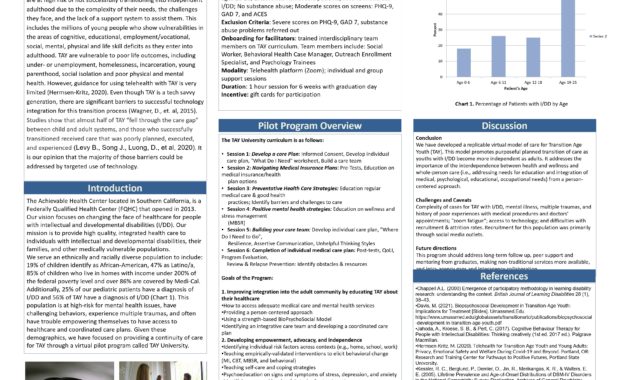A large primary care clinic completed two years implementing a four-tiered primary care treatment program for children with difficult behaviors. A
Poster 26 – A Stepped-Care Approach to Externalized Behavior Disorders: Increasing Access to Parent-Child Interaction Therapy Through Integrated Behavioral Health Care
A large primary care clinic completed two years implementing a four-tiered primary care treatment program for children with difficult behaviors. A
J05 – Suicide Prevention Training: Leveraging technology for efficient use of training resources within a large health system
The U.S. National Strategy for Suicide Prevention calls for communities to identify supportive structures that encourage efficient and sustainable
A08 – The Oak Street Health Collaborative Care Model: Integrated Behavioral Health in a High Needs, Value Based Primary Care setting
The Oak Street Health (OSH) Care Model is different from traditional healthcare models. OSH is in the fortunate position to invest in interventions to
Poster 25 – How We Move Forward: A Sustainable Model of Telehealth Practice Providing Quality & Equitable Care for Vulnerable Individuals with I/DD and MI
Providing quality care services through a pandemic has its challenges. But, adapting to virtual realities has sparked an innovative model of
K05 – Implementation of Primary Care Behavioral Health Model through Telemedicine at Jefferson Health: Lessons Learned, Areas for Growth
The U.S. healthcare system has experienced a paradigm shift in the way it delivers care since the implementation of the Affordable Care Act. Its
J09 – Examining Training Implications for Mental Health Professionals in Integrated Care: A Systematic Review
Integrated care, a healthcare reform that targets on-site collaboration of medical and mental health professionals, has become increasingly prevalent
Depth and Breadth: Building Capacity for Coordinated, Comprehensive Care through Collaboration and Collective Impact
Two complementary initiatives are advancing comprehensive care in Houston through integration of physical and behavioral health care as well as
Utilizing Virtual Care Methods and Population Health Platforms to Redefine Access to Behavioral Health Services within the Ambulatory Care Setting
Health Systems have consistently struggled to meet the need for coordinated behavioral health services due to provider shortages and financial
Steps to Sustainability: Building Financially Reimbursable Models for Primary and Specialty Integrated Care
From CJ Peeks’ Three World View (2008), it is impossible to have a clinically and operationally successful model of care without accounting for its
Primary Care Patients in Family Medicine Integrated Care and Emergency Department Utilization
Integrated care has been touted as a potential cost savings model based in part on the mechanism of medical (physical health) cost offsets (NASMHPD,
Hub-Extension Model and Access to Pediatric Behavioral Integrated Primary Care
Best practices indicates integrated BHPC services should be provided on-site for increased access to care. For some agencies, patient population may
Mapping the Territory: Using a Practical Tool to Assess Provider Perceptions of Presenting Problems Across System and Time
Patient registries, collaborative care models, and population-based screeners are just some of the tools used to identify patient need in an

